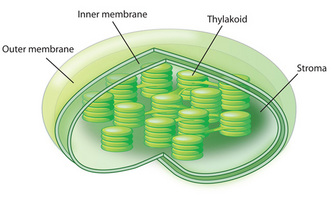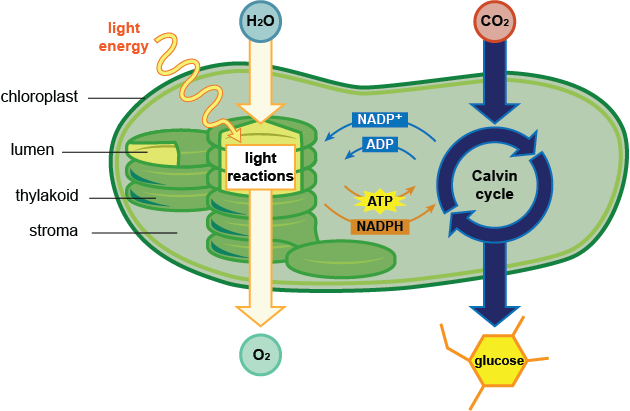SO YEA, I GOT WHAT PHOTOSYNTHESIS IS, BUT WHERE EXACTLY DOES THIS EVEN HAPPEN?
Great question! In this case, we'll be looking at photosynthesis in eukaryotes. In eukaryotes, photosynthesis occurs in a small special place located in the cell called the chloroplast, a membrane bound organelle composed of the three membranes.
The chloroplast includes:
- Outer membrane
- This covers the entire surface of the organelle
- Inner membrane
- It lies within the outer membrane
- Intermembrane compartment
- The region between the inner and outer membranes
- Stroma
- Aqueous environment within the inner membrane
- Thylakoid
- Located within the stroma and are closed, flattened sacs
- Thylakoid Lumen
- The space enclosed by a thylakoid
Again, great question! The locations of each cycle actually occur at:
For Light Reactions:
Components of light reactions of photosynthesis are embedded on the thylakoid membrane and these components include:- Proteins
- Pigments
- Electron Transfer Carriers
- ATP synthase
For Calvin Cycle:
Enzymes that catalyze the reactions of Calvin cycle are found in the stroma of the chloroplastTHE PHOTOSYNTHETIC APPARTUS
Photosynthesis is initiated by light absorption by pigment molecules which are bound precisely to particular proteins. This creates a highly functional pigment-protein complex referred to as PHOTOSYSTEM.
LIGHT- WAIT, WHAT IS LIGHT?
Light is defined as the portion of the electromagnetic spectrum that is detectable to the human eye. This ranges from 400nm (blue light) to 700 nm (red light).
The interaction of light with matter is best known as discrete packets of energy called photons. Photons of light contain a fixed amount of energy that inversely related to its wavelength. That is:
- The shorter the wavelength, the more energy photons it contains
- The longer the wavelength, the less energy photons it contains
- Energy of photon is transferred to an electron within a molecule
- As a result, it moves the electron from ground state to an excited state
WHAT DOES PIGMENTS HAVE TO DO ANYTHING WITH?
Pigments are a class of specialized molecules that absorb visible light or in other words, they absorb specific wavelengths of light. WHY PIGMENTS? Pigments in fact have structures in which results in a number of excitable electrons.
Note some important considerations:
- A single photon of light excites ONLY a single electron within a pigment molecule, raising it from ground state to excited state
- A photon light can excite an electron ONLY when the energy of the photon MATCHES the amount of energy required to raise the electron from ground state to excited state. If the energies don't match, then photons are not absorbed but rather transmitted or reflected.
After a pigment molecule absorbs a photon of light, one of the three possible events can occur:
- The excited electron from the pigment molecule returns to ground state, releasing its energy as either heat or emission of light referred to as fluorescence
- The energy of the excited electron is transferred to neighbouring pigment molecule called inductive resonance. As a result of this transfer, it excites a second molecule while the first molecule returns to ground state
- The excited electron is transferred from the pigment molecule to a nearby electron-accepting molecule called primary acceptor.
TYPES OF PIGMENTS
In photosynthesis, light is absorbed by molecules of green pigments called chlorophyll and yellow-orange pigments called carotenoids. Note that the reason why chlorophyll and carotenoids are the colours they are is because each of the pigment molecule don't have an excited state that matches the energy of the green photon or the yellow-orange photon.
Looking at chlorophyll, chlorophyll a and chlorophyll b are the dominant forms of photosynthesis
To determine the wavelength of light absorbed by a pigment, one could produce an absorption spectrum for that pigment using an instrument called spectrophotometer and a pure pigment sample.
Absorption spectrum is defined as the plot of absorption of light as a function of wavelength
Now, photosynthesis depends on the absorption of light by chlorophylls and carotenoids acting in combination. This is referred to as the action spectrum of photosynthesis.
Action spectrum is defined as the plot of effectiveness of light of particular wavelengths in driving a process
On the following page, you will find more detail about photosystems and light reactions. Be sure to visit the page to learn more.




No comments:
Post a Comment